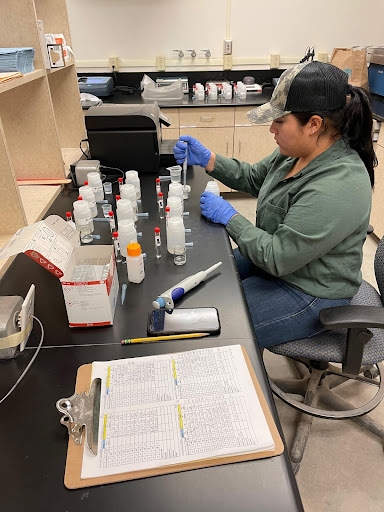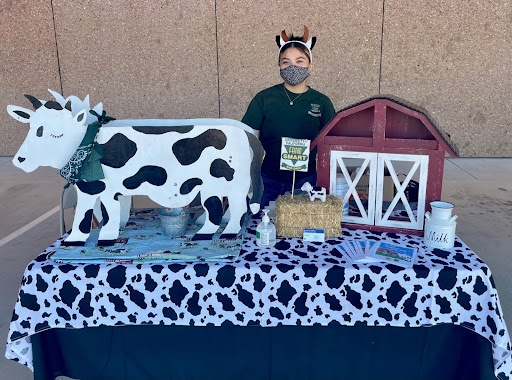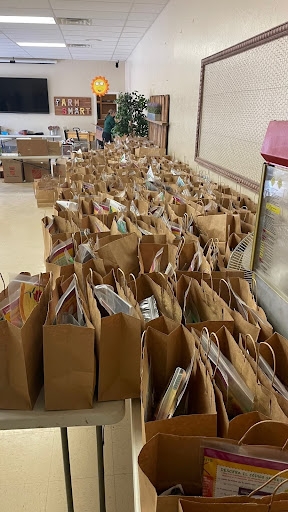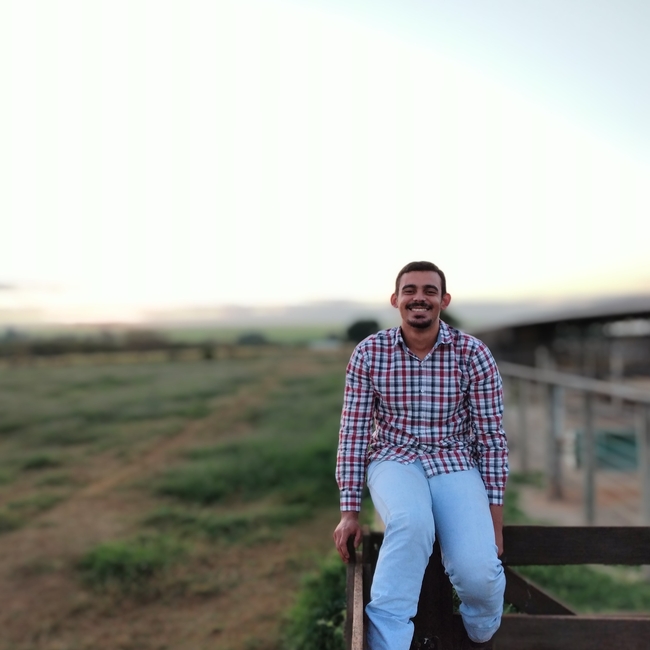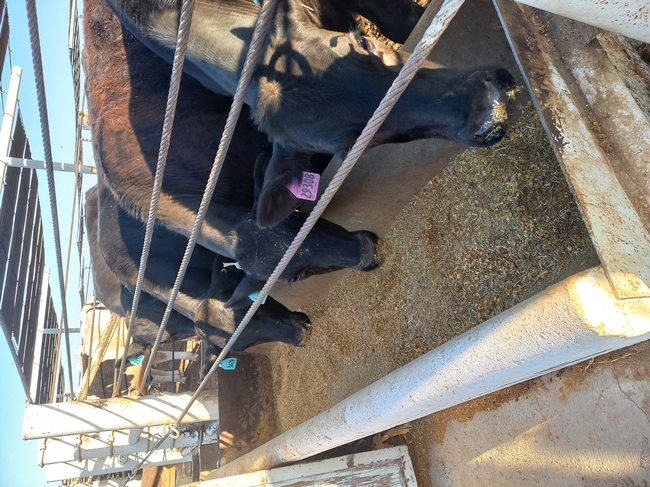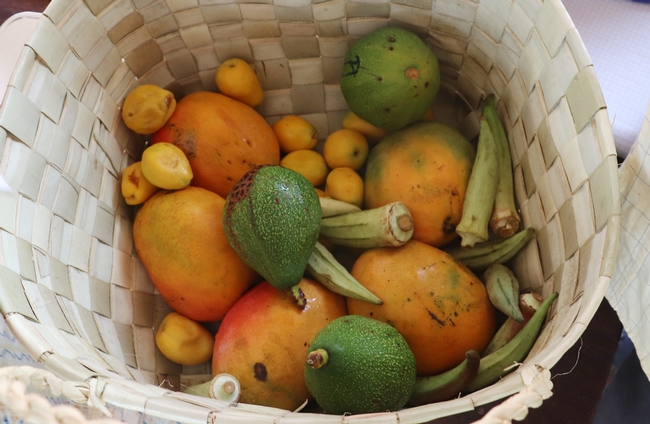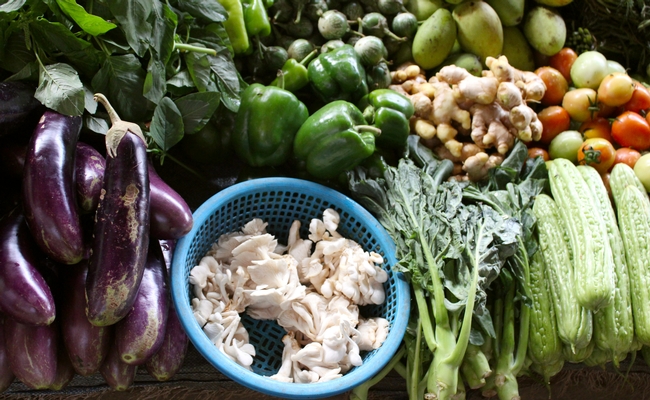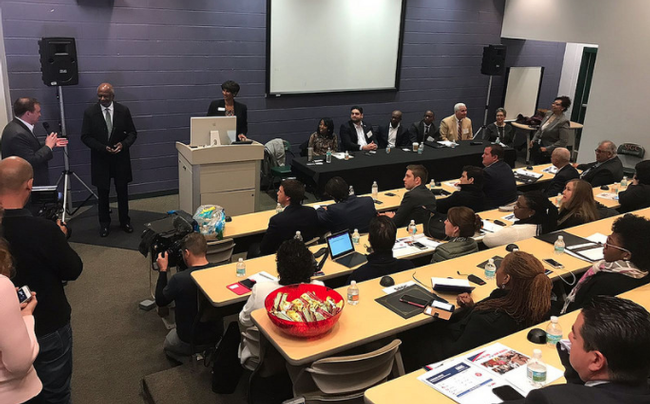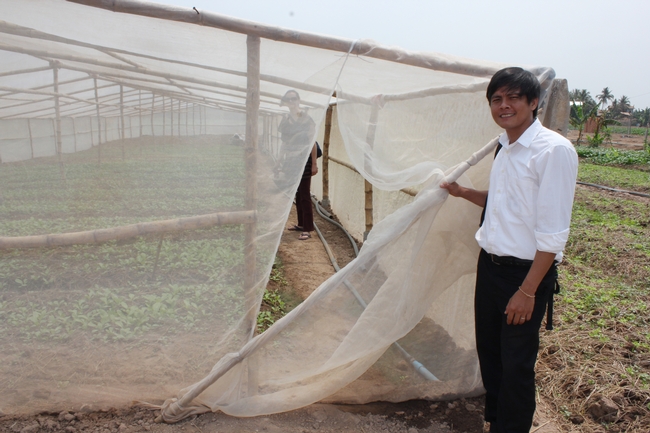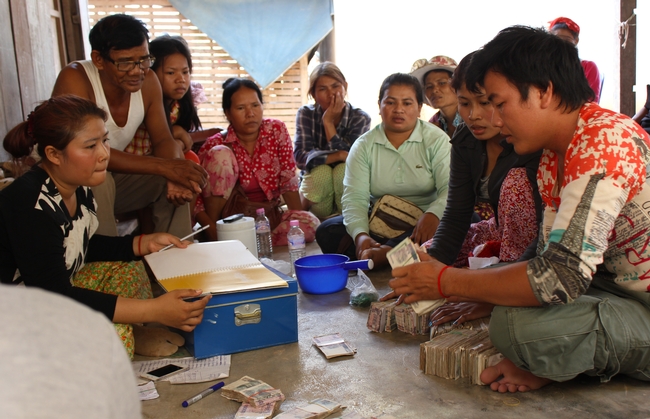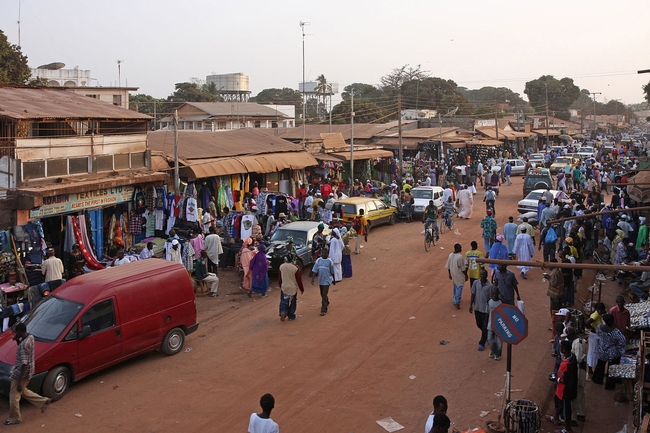Posts Tagged: international
Desert Research and Extension Center hosts international agriculture student interns
Caring for feedlot cattle, examining onion irrigation practices, and teaching preschoolers about agriculture are not part of the typical college curriculum. But for Desert Research and Extension Center's five college student interns, these activities are what fill their days.
Located on 255 acres of Southern California desert, DREC focuses on advancing irrigated desert agriculture, livestock and feedlot management, and pest management. It is also home to the Farm Smart agricultural education program, reaching approximately 7,800 participants annually.
In February, DREC welcomed the college student interns - creative thinkers working at the intersection of experimental research and agriculture education. During the internship, the students are working on-site under the mentorship of academics and staff members on applied projects. After years of COVID restrictions, the center is excited to welcome the students in person for hands-on engagement with the research and the public.
"Hosting students at DREC helps us to fulfill our mission while training the next generation of professionals," says Jairo Diaz, Director of DREC. "I am particularly motivated to provide experiential learning activities to underrepresented groups in agriculture and STEM careers."
Read on to learn about each of these budding agronomists.
Dianely Alba
Dianely Alba is majoring in agronomy at the Universidad Autonoma de Baja California, Mexico (This university is about 20 miles south of DREC). She is working under the mentorship of Jairo Diaz-Ramirez on a project focused on improving irrigation and nutrient management practices in onion production in Imperial County.
Melina Munoz
Melina Munoz is a student at Imperial Valley College studying elementary education. She is an intern for DREC's Farm to Preschool Festival. Munoz is in charge of developing and translating activities, planning and implementing the festival, and data entry for participant registration and evaluation information.
Lester Nolasco
Lester Nolasco grew up on a farm in Honduras, so he has been involved with animals and agriculture from a young age. He is working under the mentorship of Pedro Carvalho, the Feedlot Management Specialist. Nolasco is currently working on feedlot cattle management and beef cattle nutrition.
“Although my passion is cattle, when you work with these animals, you indirectly learn about agriculture and crops in general because that is also an important part of cattle nutrition,”says Nolasco. Alongside the other feedlot management interns, Nolasco feeds animals, cleans pens, mixes feed, weighs cattle, and does lab work. “It is such a nice experience for me because I had only worked with dairy cattle in the past and this internship is teaching me a lot. I would like to learn as much as I can about beef cattle nutrition. Hopefully, in the future, I will be a professor and share the knowledge I have learned with other professionals back in my country.”
Heitor Otávio Martins de Oliveira
Heitor Otávio Martins de Oliveira has worked with animals throughout his life, starting with his parents' farm. He attended veterinary school, where he continued to learn about agriculture. At DREC, Otávio Martins de Oliveira is working on beef cattle nutrition management. In addition to daily maintenance tasks, he weighs the cattle monthly and provides any necessary treatments.
“I would like to get as much knowledge as I can about nutrition in the USA and then return to my home country of Brazil to work there,” says Otávio Martins de Oliveira. “Maybe I will get a master's degree related to reproduction in cattle.”
Willi Meireles
Willi Meireles was introduced to Carvalho by his professor in Brazil. He is working on evaluating the use of feed additives to increase the performance of feedlot cattle.
“My grandparents own a farm where beef cattle are raised, so since I was a child, I have worked with animals and always liked animal science,” reflects Meireles. “I intend to specialize in ruminant nutrition and, after working hard, be able to have my own beef cattle.”
Making the case for fruits and vegetables
Why do you love fruits and vegetables? Is it their bright colors? Their many shapes and varieties, the way they can makeover your plate with the seasons? The opportunity to taste local terroir in a very fresh bite of fruit or forkful of salad?
Is it more about the juiciness, crunchiness or succulence?
Or do you think more about nutrition? About vitamins, micronutrients and fiber, after decades of being encouraged to eat “5 A Day” to be healthy? Is it about that feeling of righteous virtue when you fill half your plate with fruits and vegetables — and know you're earning a gold star for eating right?
The importance of eating fruits and vegetables has been making headlines again recently, with studies refocusing on the concept of “nutrition security” in a changing climate and pushing for an emphasis on nutrient consumption. The EAT-Lancet commission — while mostly garnering headlines in the United States related to reduced meat consumption — also recommended a diet that would require almost every global region to increase its consumption of fruits and vegetables to meet healthy diet goals.
But there's another reason to love fruits and vegetables that might not be as obvious. Here's a 30-second video clip of what a young farmer in Uganda had to tell me about vegetables, when I had the chance to meet him last year:
“There's no quicker source of getting money in town,” Boaz Otieno explained, when discussing why he chose to farm instead of going to town to find a job. He also talked about the concept that he could grow vegetables like tomatoes on a smaller plot of land and earn as much for those tomatoes as a larger plot of corn or cassava.
"You might even grow (tomatoes) twice while the cassava is not yet harvested, so there's a lot of money in horticulture," he said.
Otieno is a farmer who was also working as a site coordinator for a research project led by Kate Scow in Uganda, which was supported by the Horticulture Innovation Lab, the USAID-funded research program that I work for at UC Davis. Elizabeth Mitcham, director of the Horticulture Innovation Lab and a UC Cooperative Extension specialist, often talks about the “double-duty impacts” of fruits and vegetables, as these crops can be a tool to achieve two major global goals: improving nutrition and reducing poverty.
And it's not just one farmer's opinion that horticultural crops can yield higher incomes. In a white paper about aligning the food system to meet fruit and vegetable dietary needs, the authors pointed out that data from Africa and Asia have shown farmer profits per hectare 3-14 times higher when growing vegetables versus growing rice. The paper also points out that USDA estimates fruits and vegetables account for 23 percent of production value in American agriculture, grown on less than 3 percent of the country's agricultural land. And here in California, fruits and vegetables are a $20 billion industry.
Later this month, the Horticulture Innovation Lab will be hosting a conference in Washington, D.C., focused on making the case for fruits and vegetables with the theme, “Colorful Harvest: From Feeding to Nourishing a Growing World.” The conference will bring together decision makers, international development practitioners, and researchers from universities across the United States, Africa, Asia and Central America to discuss how horticultural innovations can advance global issues of food security, food waste, gender empowerment, youth employment, malnutrition, and poverty reduction.
While the conference speakers and participants will be diverse, we're also working to bring farmers' voices — like Otieno's — into the conference with video clips from our partners in Nepal, Honduras, Rwanda and elsewhere, to explain what exactly it is that makes them love fruits and vegetables.
More information:
- Conference info: Colorful Harvest: From Feeding to Nourishing a Growing World
(Check the conference webpage for more videos and presentation info after the event.) - White paper: Aligning the Food System to Meet Dietary Needs: Fruits and Vegetables
- More about the Horticulture Innovation Lab
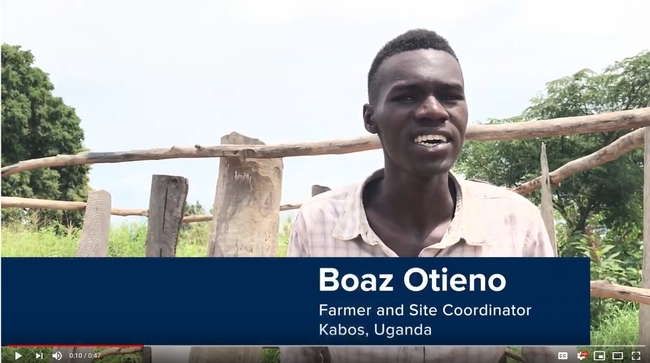
Watch a short video clip on what Boaz Otieno likes best about vegetables: https://youtu.be/aEu9BgL9aH4
UC ANR to host exchange in Northern California promoting business partnerships across the Americas
The tenth Americas Competitiveness Exchange on Innovation and Entrepreneurship (ACE) will be held for the first time in Northern California in October. To promote partnerships, the exchange will bring economic and political leaders from across the Americas and beyond to visit Northern California's world-class innovation and entrepreneurship ecosystems, and to experience the best California has to offer in food, wine and local products. The milestone “ACE 10” is sponsored by the University of California Agriculture and Natural Resources, Central Valley AgPlus and other California partners.
From Oct. 21 to 27, approximately 50 high-level economic and political leaders from across the Americas, selected through a competitive application process, will participate in ACE 10, which will highlight innovation and entrepreneurial activity.
ACE 10 program themes include:
o Improving health: Bioscience, food safety, healthy food access and nutrition
o Feeding the world: Sustainable food systems & communities, food security, ag tech
o Maximizing resources: Resource management, water and energy, waste-to-energy uses
o Fostering resiliency: Environmental sciences, mobility, global leadership
o Innovation ecosystems: Innovation communities, supporting entrepreneurs, financing ventures
“The University of California is pleased to host the milestone ACE 10 in Northern California to highlight our world-class innovation and entrepreneurship that drives local and regional economic development,” said Glenda Humiston, UC vice president of agriculture and natural resources. “We look forward to building new and lasting partnerships across the Americas.”
The ACE 10 program will start in San Francisco at UCSF's renowned biotech research center and start-up incubator in Mission Bay, followed by a visit to NASA Ames Research Center. The tour includes stops in Santa Cruz, Monterey, Salinas, Fresno, and Davis, and will conclude in Sacramento. Site visits will focus on food and agriculture, water and energy technologies, life and environmental sciences and advances in manufacturing.
“It's a tremendous honor and important opportunity for Northern California to host the 10th Americas Competiveness Exchange,” said Valley Vision's chief executive Bill Mueller. “Hosting this global delegation gives California not just the chance to showcase our assets, but also provides an unmatched platform to build global economic and research alliances.”
Gabriel Youtsey, UC ANR chief innovation officer agrees. “Innovation and entrepreneurship are California's biggest ‘exports' to the world and we aim to set off the next wave of innovation in our state's distinct areas of strength: food, agriculture and life sciences.”
The agenda is designed to provide the delegates opportunities for interactive learning, sharing of best practices, networking and partnership development as they travel from the coast to the inland areas of the state. “During the tours, our visitors will discover opportunities and create new collaborations that will continue to flourish long after they return to their home countries,” Humiston said.
ACE toured the Arizona-Southern California corridor in 2016. The most recent exchange, ACE 8, was held in Florida in December 2017. ACE 9 will be held in Israel and Germany this June where the baton will be passed to Humiston to take lead on ACE 10.
Valley Vision—a civic leadership organization headquartered in Sacramento that is committed to building a prosperous and sustainable future—is a co-host for ACE 10, along with UC ANR. The Northern California leadership team also includes California State University, Fresno and California State University, Chico; the cities of Davis, Fresno, Sacramento, Salinas, San Francisco and Santa Cruz; Bay Area Metro and Monterey County. The successful bid to host ACE 10 is an outgrowth of the Central Valley AgPlus food and beverage manufacturing consortium.
The principal ACE convening institutions are the U.S. Department of Commerce, through the International Trade Administration (ITA) and the Economic Development Administration (EDA); the U.S. Department of State; the Government of Argentina;and the Organization of American States (OAS) as the Technical Secretariat for the Inter-American Competitiveness Network (RIAC). ACE is a core component of the Work Plan of the Inter-American Competitiveness Network.
Past examples of mutually beneficial partnerships developed by ACE exchanges include:
• Research centers and co-ops such as Organic Valley in Wisconsin and Escuela Superior Integral Lecheria (ESIL) of Villa María in Cordoba, Argentina, working on business and export development in the dairy industry;
• Young entrepreneurs from UNITEC Honduras interacting and collaborating with the entrepreneurship ecosystems led by UC San Diego;
• An industrial internship program between Canada and Mexico through Mitacs, a Canadian not-for-profit research and training organization, and Mexico's National Council of Science and Technology (CONACYT).
Building trust in food systems – here and in Cambodia
What is the role of trust in our food system? Here in the United States, our trust in food is often implicit. We can generally trust that the fruits and vegetables we buy at a grocery store or farmers market are safe to eat — and we are often free to shop without even thinking about that trust.
Between farmers and agricultural scientists too, trust often plays an important role. If you're a farmer, you need to be able to trust that investing your time or money in a new technique or in attending a workshop will indeed improve your business.
But it can be easy to forget that trust is a critical first step in many of these agricultural relationships.
Establishing trust between actors in a food system has been critical for a Horticulture Innovation Lab project in Cambodia, focused on increasing the amount of safe vegetables available to Cambodian consumers. Project leaders from UC Davis and UC ANR — Glenn Young, Jim Hill, Cary Trexler, David Miller and Karen LeGrand — are actually traveling right now in Cambodia to launch a new phase of this project. They are partnering with scientists from Cambodia's Royal University of Agriculture and the University of Battambang. The researchers plan to expand upon their past successes, working together with farmers, marketers, and input suppliers to build trust while building safe vegetable value chains.
One key to their past success was that before introducing farmers to new agricultural technologies, the researchers first connected with farmers socially, by starting community savings groups. In these savings groups, farmers could build relationships and trust, while increasing their own savings and accessing small loans.
This social aspect of the project was the focus of a video made by UC Davis graduate students Thort Chuong, Elyssa Lewis, and Katie Hoeberling. This 3-minute video was a finalist in the World Food Day Video Challenge:
Building trust and resilience in a safe vegetable value chain in Cambodia Interviews for the video were conducted as part of a student thesis and supported by the U.S. Borlaug Graduate Research Fellowship program.
Though he is now studying at UC Davis as a Fulbright Fellow, Chuong was originally hired to work with farmers on the first phase of this project in Kandal province as an agronomist and field facilitator.
“At first I just wanted to focus on the agronomy part,” he said. “But then I saw the advantages of being a [savings group] member and thought, wow, this is a great thing to do.”
In fact the advantages were so great that on the weekends he returned to his hometown, gathering his neighbors and relatives together to start their own savings groups. Members have a safe way to save money, an easier way to secure small loans, and earn a little interest too.
Farmers in these savings groups were able to save considerable amounts of money and provide loans to each other for things like seeds, field preparation, labor costs, school fees, wedding costs, even in one case a new house — with each member contributing $5-25 per week for a year.
With trust and community established, some of the farmers in the savings groups also decided to try out a new agricultural technology in partnership with the scientists, using nethouses for pest management to avoid spraying pesticides. (In many countries where pesticide information is inaccessible to the average farmer, it is not uncommon for farmers to keep a separate garden to feed their family — in order to avoid eating even their own crops that they are selling to the market.)
The new, safe vegetable value chain they were part of grew and strengthened, as the international team connected these farmers to a marketer who needed to source vegetables grown without pesticides. That marketer then sells those vegetables to consumers in the capital city of Phnom Penh, who were able to trust the vegetables they bought from her are indeed safe to eat.
The Horticulture Innovation Lab is led by a team at UC Davis, with funding from the U.S. Agency for International Development, as part of the U.S. government's global hunger and food security initiative called Feed the Future. Learn more about Horticulture Innovation Lab researchers and their projects in Asia, Africa and Central America.
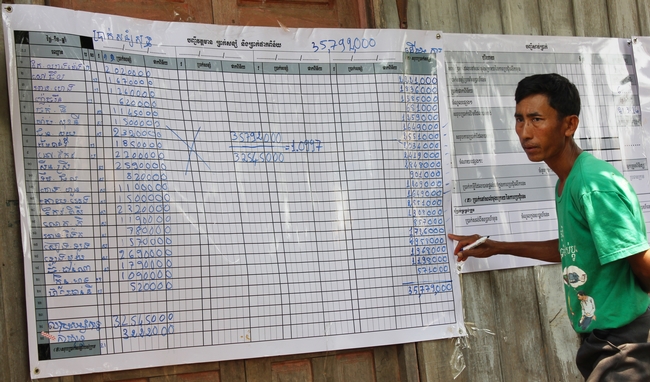
As the savings group secretary, Nov Keo tallies up the year's total savings, loans, and interest during the end-of-year ceremony. He was also one of the first farmers to try using a nethouse to grow "safe vegetables" for the Phnom Penh market.
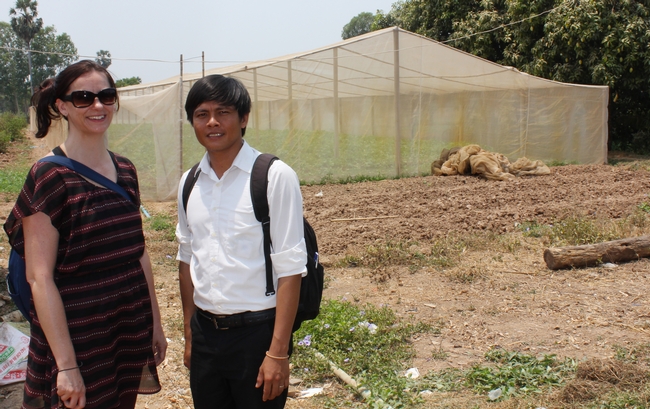
UC Davis researcher Karen LeGrand with Thort Chuong, in front of another farmer's nethouse in Cambodia built after they helped connect scientists, farmers, and marketers with technologies from the Horticulture Innovation Lab.
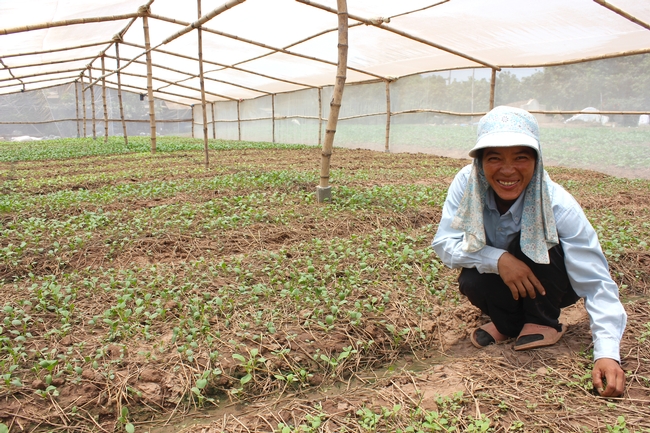
Cheng Sokhim is one of the farmers who started using a nethouse for safer pest control and to earn higher prices for her leafy greens such as kale, Chinese mustard, bok choy and curly leaf lettuce.
Changes in breast milk sugars impact babies’ health and growth
When it comes to nursing moms and their babies, an elegant web of cause and effect connects climate, breast milk, gut microbes and infant health.
That web was clearly illustrated by a recently published study involving 33 women and their babies in the West African nation of The Gambia. The research team, including scientists from UC Davis and UC Agriculture and Natural Resources, found that complex breast milk sugars called oligosaccharides helped protect nursing babies from illness and also influenced the mixture of microbes in the infants' guts.
The researchers also showed that changes in food availability from season to season could affect the composition of the women's breast milk and the protective quality of the babies' gut microbiota. And those changes, in turn, impacted the health and growth of the breastfed infants.
Composition of breast-milk sugars and infant health
Oligosaccharides occur abundantly as more than 200 different chemical structures in human breast milk. It's been known for some time that these complex sugars contribute to infant health by supporting the growth of beneficial bacteria in the baby's gut. And these gut bacteria have been shown to play a key role in fending off infectious illnesses.
But little has been known about how changes in the composition of the breast milk sugars might affect the health and growth of infants, especially those living in areas where infection rates are high.
To explore that relationship, the researchers monitored the composition of the oligosaccharides in the mothers' milk and examined the infants' gut microbiota at 4 weeks, 16 weeks and 20 weeks after the babies were born. Then they analyzed the data, looking for possible relationships to the health and growth of the babies and the status of their gut microbes.
They found that two of the oligosaccharides, lacto-N-fucopentaose and 3′-sialyllactose, had a direct relationship to the babies' health and growth. High levels of the former were associated with a decrease in infant illness and with improved growth, measured as height for age, while the latter proved to be a good indicator of infant growth, measured by weight per age.
“Our findings provide evidence that specific human milk oligosaccharides can alter the composition of breast milk, making it more protective against infection and allowing the infant to invest energy in growth rather than fending off disease,” said the study's corresponding author Angela Zivkovic, an assistant professor of nutrition at UC Davis.
Influence of wet and dry seasons
The researchers also were curious how seasonal shifts in food availability, which significantly impact the mothers' diets, might be reflected in breast milk composition and infant health.
The Gambia has two distinct seasons, the wet season from July to October and the dry season from November to June.
The wet season is also known as the “hungry” season because it is the time of year when food supplies tend to be depleted, infection rates rise and the farming workload is highest. In contrast, the dry, or “harvest,” season is characterized by plentiful food supplies as well as significantly higher energy stores and less illness among the local people.
The researchers found that mothers who were nursing during the wet or “hungry” season produced significantly less oligosaccharide in their milk than did those nursing during the dry season.
In examining the makeup of the babies' gut microbiota, the researchers noted that most of the bacteria belonged to the Bifidobacteria genus. They also discovered that higher levels of Dialister and Prevotella bacteria were accompanied by lower levels of infection.
In addition, higher levels of Bacteroides bacteria were present in the infants' guts that had abnormal “calprotectin” – a biomarker associated with intestinal infections.
“We are very interested in which specific dietary factors influence the oligosaccharide composition of mother's milk,” Zivkovic said. “If we can find the mechanisms that change the composition of breast milk sugars, we may have a new approach for modifying the infant microbiota and ultimately influencing the health and vigor of the nursing baby.”
The study by Zivkovic and colleagues appears online in the journal Scientific Reports. The research is part of a long-running, cross-disciplinary project at UC Davis examining milk and its role in nutrition.
Funding for the study was provided by the National Institutes of Health, UK Medical Research Council, Bill and Melinda Gates Foundation, Alfred P. Sloan Foundation, and Peter J. Shields Endowed Chair in Dairy Food Science at UC Davis.

